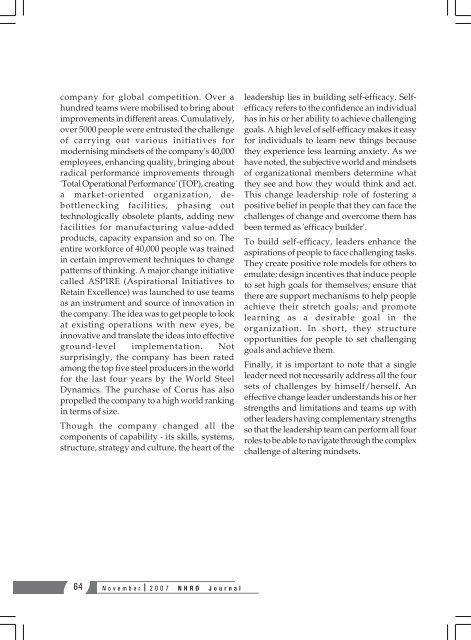NHRD Journal - National HRD Network
NHRD Journal - National HRD Network
NHRD Journal - National HRD Network
You also want an ePaper? Increase the reach of your titles
YUMPU automatically turns print PDFs into web optimized ePapers that Google loves.
company for global competition. Over a<br />
hundred teams were mobilised to bring about<br />
improvements in different areas. Cumulatively,<br />
over 5000 people were entrusted the challenge<br />
of carrying out various initiatives for<br />
modernising mindsets of the company's 40,000<br />
employees, enhancing quality, bringing about<br />
radical performance improvements through<br />
'Total Operational Performance' (TOP), creating<br />
a market-oriented organization, debottlenecking<br />
facilities, phasing out<br />
technologically obsolete plants, adding new<br />
facilities for manufacturing value-added<br />
products, capacity expansion and so on. The<br />
entire workforce of 40,000 people was trained<br />
in certain improvement techniques to change<br />
patterns of thinking. A major change initiative<br />
called ASPIRE (Aspirational Initiatives to<br />
Retain Excellence) was launched to use teams<br />
as an instrument and source of innovation in<br />
the company. The idea was to get people to look<br />
at existing operations with new eyes, be<br />
innovative and translate the ideas into effective<br />
ground-level implementation. Not<br />
surprisingly, the company has been rated<br />
among the top five steel producers in the world<br />
for the last four years by the World Steel<br />
Dynamics. The purchase of Corus has also<br />
propelled the company to a high world ranking<br />
in terms of size.<br />
Though the company changed all the<br />
components of capability - its skills, systems,<br />
structure, strategy and culture, the heart of the<br />
leadership lies in building self-efficacy. Selfefficacy<br />
refers to the confidence an individual<br />
has in his or her ability to achieve challenging<br />
goals. A high level of self-efficacy makes it easy<br />
for individuals to learn new things because<br />
they experience less learning anxiety. As we<br />
have noted, the subjective world and mindsets<br />
of organizational members determine what<br />
they see and how they would think and act.<br />
This change leadership role of fostering a<br />
positive belief in people that they can face the<br />
challenges of change and overcome them has<br />
been termed as 'efficacy builder'.<br />
To build self-efficacy, leaders enhance the<br />
aspirations of people to face challenging tasks.<br />
They create positive role models for others to<br />
emulate; design incentives that induce people<br />
to set high goals for themselves; ensure that<br />
there are support mechanisms to help people<br />
achieve their stretch goals; and promote<br />
learning as a desirable goal in the<br />
organization. In short, they structure<br />
opportunities for people to set challenging<br />
goals and achieve them.<br />
Finally, it is important to note that a single<br />
leader need not necessarily address all the four<br />
sets of challenges by himself/herself. An<br />
effective change leader understands his or her<br />
strengths and limitations and teams up with<br />
other leaders having complementary strengths<br />
so that the leadership team can perform all four<br />
roles to be able to navigate through the complex<br />
challenge of altering mindsets.<br />
64<br />
November 2007 <strong>N<strong>HRD</strong></strong> <strong>Journal</strong>
















